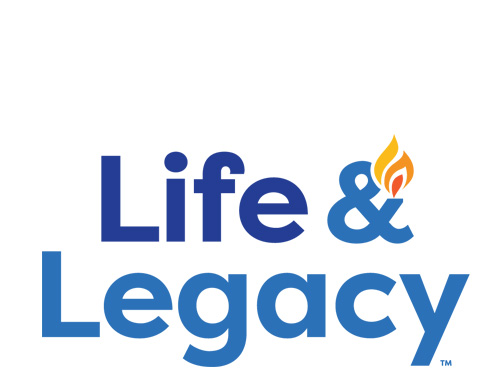Schechter Shavua: June 2, 2023
Early Childhood Finds Inspiration in Artistic Techniques
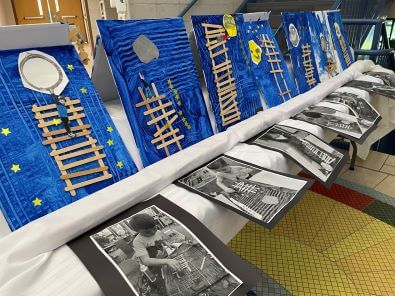 Last week, the Early Childhood classes invited beloved guests to visit their art gallery filled with work influenced by three inspirational artists. The EC Art Culmination has become a beloved tradition: each class first studies, in-depth, a particular artist or style of art that serves as a springboard for their own artistic inspiration; the students create their own works in the style of these artists.
Last week, the Early Childhood classes invited beloved guests to visit their art gallery filled with work influenced by three inspirational artists. The EC Art Culmination has become a beloved tradition: each class first studies, in-depth, a particular artist or style of art that serves as a springboard for their own artistic inspiration; the students create their own works in the style of these artists.
The Nitzanim class (EC2) has been learning about the art of collage since teachers Bonnie and Linda noticed how much students loved making shape collages at Passover. This spring, students have been learning about - and emulating - the colorful, repetitive and creative works of Ben Lewis Giles, a young British artist. Giles uses pictures of objects from nature such as flowers, butterflies, birds and fish to make his beautiful and often large collages.
The Shorashim Alef class (EC3-4) has been studying the Jewish American abstract artist Mark Rothko, who believed that art was truly an expression of emotion. Since Rothko used "color fields" to communicate emotions, the Alef students have connected colors with emotions. They have created their own beautiful and insightful artwork, inspired by Rothko's techniques, using a variety of materials provided by teachers Robin and Joanne.
Early in the school year,Shorashim Bet (EC3-4) teachers Julie and Sarah noticed that their students love everything about collages. So, students explored a selection of Eric Carle stories to lay the foundation for their artist study. Using a variety of materials, the children created beautiful collage masterpieces inspired by Carle’s incredible books.
Click HERE to see photos of the creative artistic process of our Early Childhood Students!
Explosive Learning in Anafim!
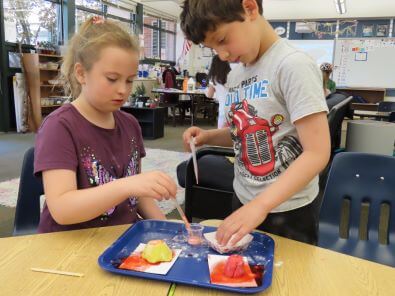 As part of Anafim’s unit on changes to the Earth's surface, students learned about how volcanoes can make changes. They put their knowledge to use, creating volcanoes on an island in the ocean, then erupting them using baking soda and vinegar. Students noticed what happened to the land and water around their volcanoes, reflecting upon what would happen to the Earth’s resources in a real volcanic eruption. Some children loved the experiment so much they went home and repeated it!
As part of Anafim’s unit on changes to the Earth's surface, students learned about how volcanoes can make changes. They put their knowledge to use, creating volcanoes on an island in the ocean, then erupting them using baking soda and vinegar. Students noticed what happened to the land and water around their volcanoes, reflecting upon what would happen to the Earth’s resources in a real volcanic eruption. Some children loved the experiment so much they went home and repeated it!
Click HEREto see volcanic photos.
Learn… then Teach
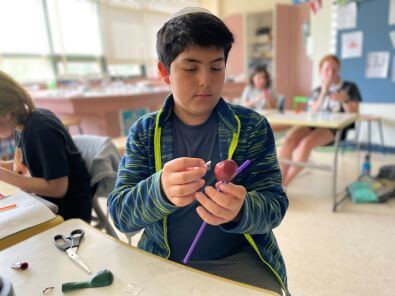 What can straws, balloons, and recycled plastic soda bottles teach you about the human body? Our middle school students can tell you! The 6th and 7th grade science students have been learning about systems of the human body and how they apply to organisms. Each group became experts on a particular body system, first researching that system, then teaching their classmates, and finally leading their peers through a hands-on lab activity about their topic.
What can straws, balloons, and recycled plastic soda bottles teach you about the human body? Our middle school students can tell you! The 6th and 7th grade science students have been learning about systems of the human body and how they apply to organisms. Each group became experts on a particular body system, first researching that system, then teaching their classmates, and finally leading their peers through a hands-on lab activity about their topic.
The digestive system group demonstrated how increased surface area helps the small intestine absorb more nutrients from food. The respiratory system group made a model lung with the class and used thinner straws to represent restricted airflow from conditions like asthma and added water to demonstrate the effects of fluid in the lungs. The nervous system group led their classmates to discover that there are many more sensory receptors for touch in their fingertips compared to other parts of their arms and hands by discriminating between a single point and two points.
The class then had the opportunity to teach their parents about these important functions during an end-of-year science program! Kol hakavod!
To see photos from their teaching and lab experiences, click HERE!
Grandparents and Special People Join the Schechter Community
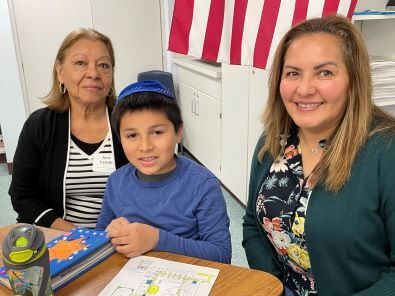 Schechter was bursting with love and smiles as hundreds of guests joined us for Grandparents and Special Persons Day! These photos are just a small representation of the morning's energy, as loved ones learned together, prayed together, and danced together!
Schechter was bursting with love and smiles as hundreds of guests joined us for Grandparents and Special Persons Day! These photos are just a small representation of the morning's energy, as loved ones learned together, prayed together, and danced together!
Parashat Naso—Seeking ways to add holiness
 I watched a lot of television when I was younger, and I still remember the famous Pantene commercial: an attractive woman with big 80s hair tossing her curls around, glancing at the camera, and purring “Don’t hate me because I’m beautiful.”
I watched a lot of television when I was younger, and I still remember the famous Pantene commercial: an attractive woman with big 80s hair tossing her curls around, glancing at the camera, and purring “Don’t hate me because I’m beautiful.”
Hairstyles come and go, but thick, vibrant locks have been associated with youthful beauty through the ages. In the Torah, there is Absalom (David’s son), Samson, and (according to Rashi), Joseph. In 18th century Europe, wealthy men and women piled their hair (and their wigs!) high. And finally, there is the ancient Greek myth of Narcissus, in which a key feature of Narcissus’s beauty was his long, fair hair. In this myth, Narcissus was a beautiful but self-centered young man who saw a reflection of himself in a pool, and was so taken with his own splendor that he realized he could not love anyone else besides himself. He wasted away, staring at his own reflection, until he died.
Interestingly, the rabbis offered their own version of the myth. In this week’s parashah, the Torah states the law of the Nazirite: a person who takes a vow to abstain from grape products, avoid death-impurity, and let their hair grow. When the term of the vow is complete, the hair is cut off and offered to God. Shimon Ha-tzadik—an ancient High Priest sometimes quoted in the Talmud—told the following story:
“In my entire life, I ate the sacrifice of a Nazirite who became impure [and who also had to shave his head] only once. This man with beautiful eyes, handsome features, and hair arranged in curls came to me from the south country. I said to him, ‘My son, why have you seen fit to destroy such beautiful hair?’”
He said, “I was a shepherd for my father in my hometown, and I went to draw water from the spring. I looked at my reflection, and my yetzer (evil inclination, represented by the hair) overcame me and sought to ruin me (with vanity). I said to it, ‘You worthless thing! Why have you become so proud of yourself? This world isn’t yours; in the end, you will be consumed by worms and maggots. By the Temple service, I swear I will cut you off, and offer you to God!’”
As Baruch Levine points out in the JPS commentary to the book of Numbers, this story is clearly inspired by the myth of Narcissus, but offers a sharp contrast. Both young men were in love with their own beauty, but whereas Narcissus was unable to overcome his self-absorption, the youth in Shimon Ha-tzadik’s story triumphed over his inclinations—by taking on Nazirite vows.
To a great extent, this comparison reflects Judaism’s approach to living a virtuous life—the idea that responsibilities and restrictions help us to be better people. Shaping our character is a primary goal of the system of mitzvot . However, mitzvot are different because in our tradition, they come from God, and we are born into them. What is interesting about the Nazir is that the restrictions are self-imposed; any individual can take them on as part of a personal spiritual path.
Nazirite vows are not part of contemporary Jewish life. Still, they represent the possibility that we can take steps away from the reflecting pool of narcissism, towards the shining light of inner goodness. May we find our way to do so, every day!
Shabbat shalom,
Rabbi Jonathan Berger
Head of School
Questions for the Shabbat table:
1. The midrash above imagines a person who took a Nazirite vow as a way to counter an obsession with physical beauty. Based on the Nazirite restrictions, can you imagine other reasons a person might have taken those vows?
2. What’s the power of having responsibilities that are externally imposed? What’s the power of responsibilities that we voluntarily take on?
Solomon Schechter Day School
of Greater Hartford
26 Buena Vista Road
West Hartford, CT 06107
© Solomon Schechter Day School of Greater Hartford | Site design Knowles Kreative


